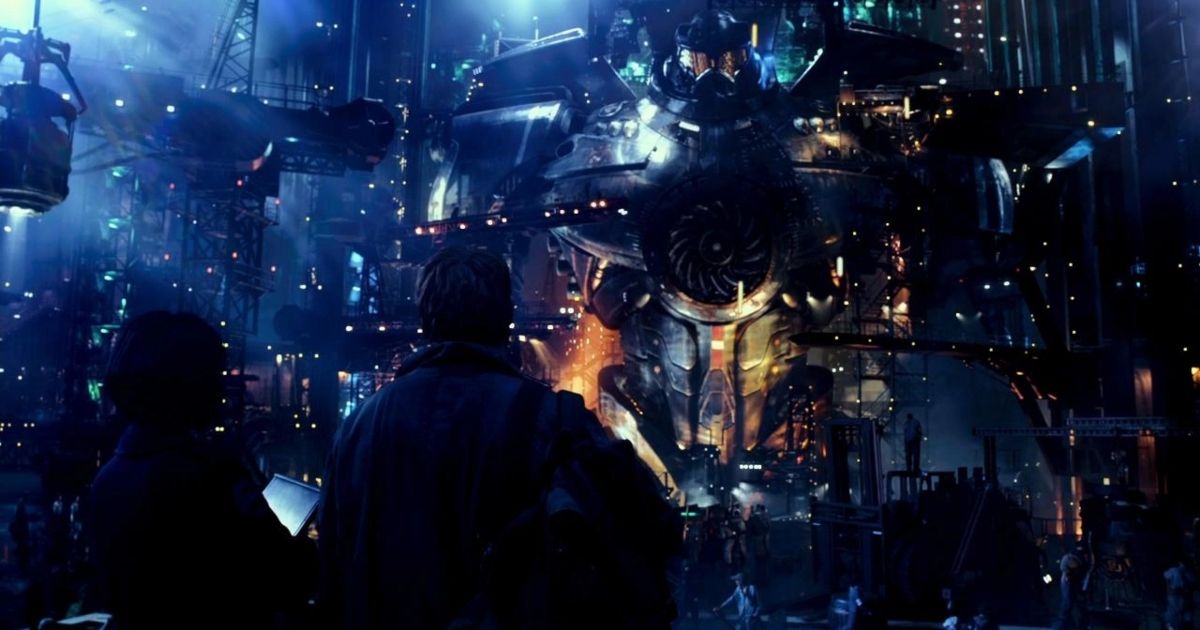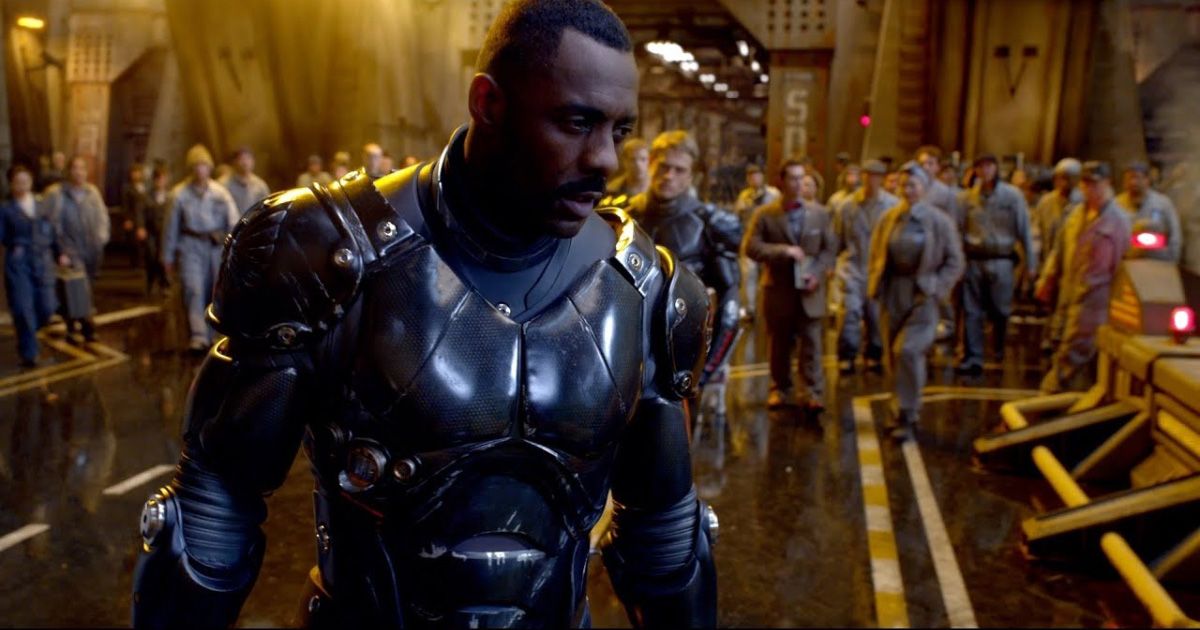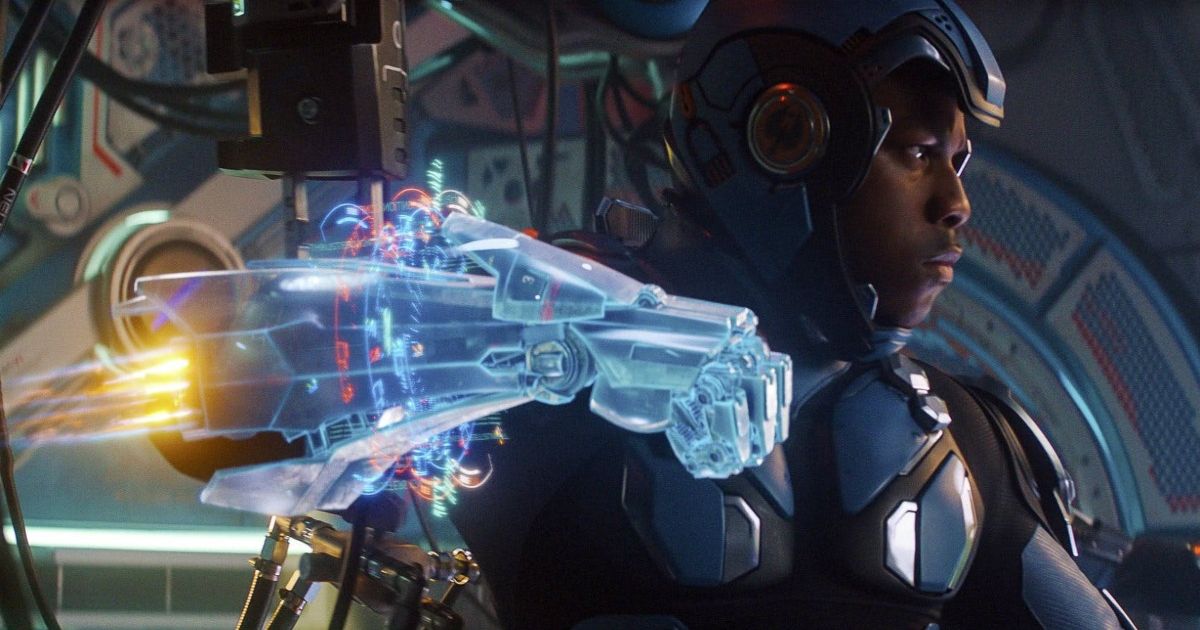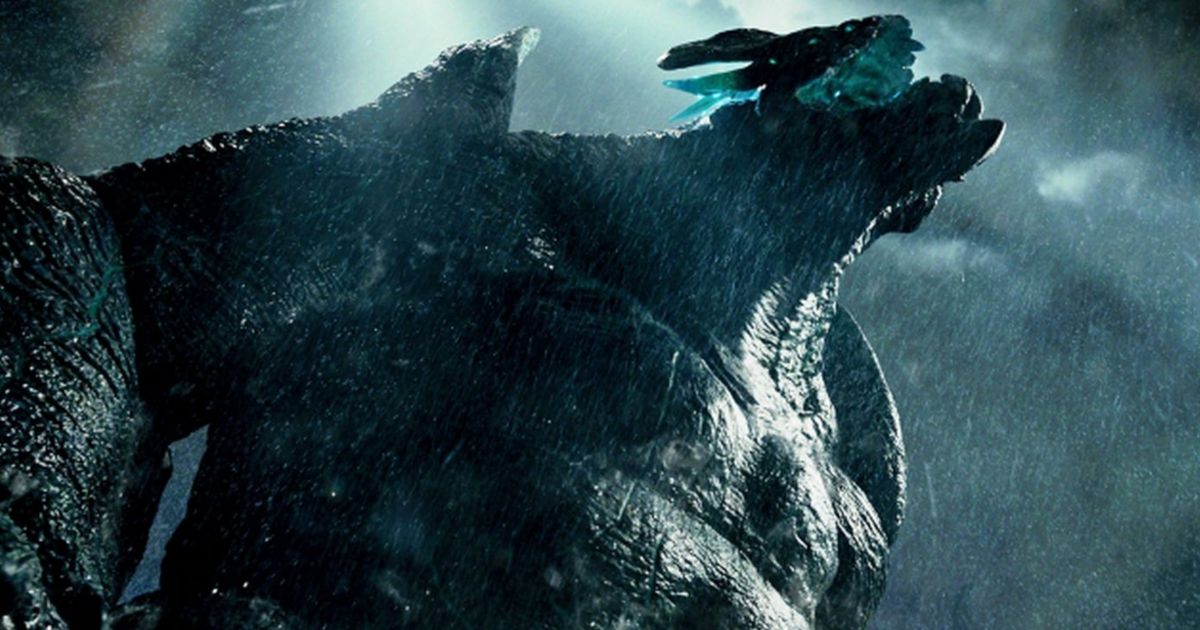Guillermo del Toro is one of the most legendary and beloved directors in all of Hollywood right now. Over the last three decades, he has been the creative mind and director behind many of the most acclaimed and original films to hit theaters. Whether it be Pan’s Labyrinth, his two Hellboy films, his Oscar-winning romance The Shape of Water, or his newest animated adaptation of Pinocchio, every new Guillermo del Toro film has been destined to become a cult classic that will be discussed and written about for years to come. One of the most interesting projects that del Toro was attached to but ultimately had to walk away from was a two-part adaptation of The Hobbit in the latter years of the 2000s. However, after he walked away from that project, he would end up tackling one of the most ambitious films of his career instead: 2013’s Pacific Rim.
The simplest pitch for Pacific Rim is that it’s pretty much just giant robots fighting giant monsters. It’s the kind of stuff that would come from a child’s imagination while they are playing with their favorite toys alone in their bedroom, and that is meant as the highest compliment. To bring this vision to life, the director was given a budget of nearly $200 million, the largest for any of his films to date. Of course, with del Toro at the helm, there’s much more depth and intrigue to be found beneath the surface of Pacific Rim than one would initially expect.
Update September 25, 2023: With news that Guillermo del Toro wants to do an IMAX re-release of Pacific Rim to honor the film's 10-year anniversary, this article has been updated with more material about the popular film.
While the movie more than delivers on the titan-sized battles, it can also be a powerful tale of loss and desperation. This year marks the tenth anniversary of the film's release, and over those years, Hollywood has become increasingly dominated by grand-scale blockbusters. Now that del Toro’s gargantuan science-fiction fight night has been allowed to age a bit, here’s how it still holds up.
The Visual Effects
With a story and concept as over-the-top as Pacific Rim, there are obviously going to be a good amount of visual effects in the film. Pacific Rim is easily one of the most digital effects-heavy movies of the last decade. That could be a blessing or a curse for the film in the long term, as poor CGI in a movie like this could really undercut a lot of the film’s most exciting and engrossing moments. When the film was released, the visual effects were one of the elements that were most praised. Thankfully, even with the advancements in digital technology over the last decade, the CGI in Pacific Rim not only holds up well but is arguably more impressive than a lot of what gets released today.
Both the design of the mechanical Jaegers and the monstrous Kaiju that they fight are incredibly distinct from most other major franchises today. They are all supremely well-realized, with each new monster or robot that arrives on the scene having its own unique design that makes it stand apart from the rest. Great design only goes so far, though, where these titans really come to life is through the digital effects. They all feel incredibly real and alive, even when they are beating each other up on the brink of an interdimensional rift on the seafloor. Industrial Light & Magic was the visual effects company that primarily worked on the film, and they thoroughly upheld their reputation of producing some of the most breathtaking and seamless effects in cinema’s history.
One of the key elements that make Pacific Rim’s effects work so well is that, while a majority of them were produced digitally, not all of them were. There were still practical effects and models used throughout the making of the film, which they utilized in conjunction with the digital effects created on a computer. One of the film’s most talked-about shots is a moment in which the Jaeger Gipsy Danger’s fist travels through a building, slows down to tap a Newton’s Cradle, and then pulls back out to punch an attacking Kaiju. The interior of that shot, which shows an office space being destroyed by the fist, was created using practical model work, with the fist of the Jaeger then added in digitally later. The result is a brief moment, in the midst of this massive CGI fight, where everything feels much more real and tangible. It’s through the use of small moments like this and those kinds of practical effects that ILM and del Toro were able to keep the film grounded and maintain the sense of reality, despite the utter madness that unfolds within the movie itself.
Premise and Story
To cut straight to it, the story of Pacific Rim has never been its strongest asset. The concept is intriguing enough as an introduction into the world, as the idea of humanity building these giant machines to fight gargantuan aliens coming out of a wormhole at the bottom of the Pacific Ocean is just absurd enough to be immensely entertaining. The set-up of the story is also compelling, with a Jaeger needing two pilots to operate and our lead character losing his brother/co-pilot during a Kaiju fight in the opening act of the movie.
Beyond that, the performances from the cast in the movie are hit-and-miss. While there are a few positive standouts, most of the cast really struggle with the material they are given. Pacific Rim is an insanely cartoony movie, so it would seem necessary for the cast to give comically over-the-top performances to match that tone. However, only a few actors in the film are able to strike the delicate balance between giving an exaggerated performance and becoming a caricature. The only real positive standouts are Idris Elba as General Stacker Pentecost and Perlman as Hannibal Chau.
Even though the thinness of the plot and the distracting performances of Pacific Rim are certainly weak points of the movie, it’s important to recognize that those elements aren’t the reasons that people watch the movie. People watch Pacific Rim to experience the truly outlandish action sequences that del Toro has to offer with the movie, and in that sense, the movie holds up pretty perfectly. The action sequences of the film aren’t just generic punching matches with an enormous budget behind them. They are genuinely well-constructed and well-written sequences. They are often extended scenes with multiple layers and elements at work within them.
Despite some of them being quite long, they each have a real sense of momentum and excitement that keeps the viewer engaged the entire time. Pacific Rim worked in 2013 because it was a true popcorn spectacle, and it’s for precisely the same reason that the movie still stands tall today, even when watching it at home. It’s an endlessly entertaining film, even if some of the material in it isn’t the best. The movie achieves what it set out to do, and it’s still doing it better than most movies a decade later.
The Expanded Lore of Pacific Rim
As well as the movie itself holds up, it’s hard to talk about how Pacific Rim has aged without at least bringing some attention to the expansion of the series that followed it. The first film was a modest success at the box office, but it wasn’t the massive hit that Warner Bros and Legendary were hoping for, given its $200 million budget.
However, thanks in part to immense desire from its passionate fan base, a second Pacific Rim movie was eventually green-lit. Universal Pictures picked up the film rights. Unfortunately, when Pacific Rim: Uprising hit theaters in early 2018, it was easy to see that the sequel was nowhere near the same quality as the original.
There are a lot of issues with Pacific Rim: Uprising, but the biggest key difference between it and its predecessor is the team that created the film. Del Toro did not return to direct the second film and ended up only playing a producing role in its development, while Travis Beacham, the creator, and co-writer of the first film, was not involved with the second film at all (at least, not the very one that we got). After being passed from one writer to another for several years, the film eventually landed in the lap of Steven S. DeKnight, who, fresh off his role developing Netflix’s Daredevil series, ended up directing the new film. The film served as a direct sequel to the first in the sense that it continued the overall events of that world, but very few members of the original cast returned, with John Boyega stepping in to play the new lead, Jake Pentecost, the son of Elba’s character from the first film.
After Pacific Rim: Uprising failed to wow critics or connect with audiences, any development on a third film ceased. While there has since been a fairly well-received two-season animated series on Netflix, titled Pacific Rim: The Black, that series also did not build much viewership. As a result of both, the Pacific Rim series seems to be dead in the water. Neither of the projects that followed the first Pacific Rim managed to recapture the energy of the first film, and ultimately, they did little more than dilute the brand and its reputation.
So, while the first film in the series has aged very well and is definitely worth a re-watch, it has since been undercut by disappointment and diminishing returns. At this point, the best way to watch the first Pacific Rim film is in a bubble, ignoring everything that followed it. If you can do that, then the IP still holds its place as a real high point in modern blockbuster cinema.
Pacific Rim: 10 Years Later
With two feature films and an animated show, it would be easy to say Pacific Rim has been a mismanaged IP, and while the assessment would be fair to some extent, it would also be a half-truth. Kaiju films haven't been a staple for American audiences, they are mostly a Japanese endeavor; one they have mastered all too well with a long string of franchises.
Pacific Rim changed that. While Warner Bros. and Legendary were already in development on their remake of Godzilla, which was set for release one year after Pacific Rim, the film was a good foundation for getting American audiences ready for giant monster spectacles like never before. Godzilla was a box office hit and kicked off a successful franchise, The Monsterverse. Pacific Rim helped popularize the term kaiju for American audiences. Even if the MonsterVerse films call them "titans", everyone knows they are kaiju.
Pacific Rim now stands as an interesting film. Del Toro has now gone from a respectable filmmaker to an Academy Award winner as he followed up Pacific Rim with The Shape of Water, which won Best Picture. It was released the same summer as the Warner Bros. film Man of Steel. Man of Steel did better at the box office than Pacific Rim but earned fewer positive reviews. Even though it kicked off the DCEU, that era is set to end this year. Yet Pacific Rim remains a beloved film by both fans of Guillermo del Toro and new audiences who discover it every year who might not have even been born when the movie was released.
In 2013, Warner Bros. put a lot of backing behind an original idea by an auteur filmmaker and gave it a big summer release date. Even with the dual success of Barbie and Oppenheimer this year, it still feels like studios are afraid to trust filmmakers with original ideas. Studios want to put their money behind sequels, reboots, and new adaptations. Sometimes, they are good, but we still need original ideas. Pacific Rim came at an interesting time in Hollywood, one that seems now like a distant memory when a movie like this could get made.

.jpg)



